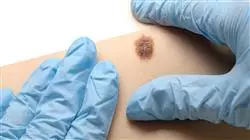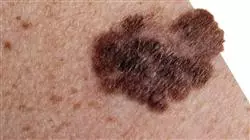University certificate
The world's largest faculty of medicine”
Introduction to the Program
You will improve your knowledge of the genetics of skin cancer, associated syndromes and the genes most susceptible to Melanoma with this Postgraduate diploma"

Despite the various treatment options available for Melanoma, recent studies show worrying figures, as cases of this pathology continue to increase worldwide, consolidating as one of the main types of Skin Cancer. That is why, for medical professionals, it is crucial to be updated on the latest scientific evidence that will allow them to apply more advanced diagnostic techniques and therapies in the clinical setting for this disease.
This is why TECH has created this program that offers the specialist a first level introduction to the advanced biology of the skin, the genetics of cutaneous cancer and the classification of skin cancer. Also, you will be able to expand your knowledge in the Molecular and classification of Melanoma and the clinical stages of Melanoma. Additionally, they will delve into reconstructive surgery, Mohs micrographic surgery and Photodynamic Therapy.
This Postgraduate diploma is presented under a 100% online method, which provides professionals with a series of multimedia materials such as real case studies and detailed videos, accessible 24 hours a day. In addition, this academic option is characterized by having one of the most revolutionary systems in the academic field, the Relearning method. This will allow graduates to remember the most complex concepts in less time and all this from any digital device with an Internet connection and anywhere in the world.
You will delve into the classification of Melanoma, such as Basal Cell Carcinoma and Squamous Cell Carcinoma of the skin"
This Postgraduate diploma in Melanoma contains the most complete and up-to-date scientific program on the market. The most important features include:
- The development of case studies presented by experts in Dermatology, Oncology and Plastic and Reconstructive Surgery
- The graphic, schematic and eminently practical contents with which it is conceived gather scientific and practical information on those disciplines that are indispensable for professional practice
- Practical exercises where self-assessment can be used to improve learning.
- Its special emphasis on innovative methodologies
- Theoretical lessons, questions to the expert, debate forums on controversial topics, and individual reflection assignments
- Content that is accessible from any fixed or portable device with an Internet connection
You will study in depth the analysis of diagnostic tests in Skin Cancer, Biopsies and Skin Ultrasounds for a better treatment of the disease"
The program’s teaching staff includes professionals from the field who contribute their work experience to this educational program, as well as renowned specialists from leading societies and prestigious universities.
The multimedia content, developed with the latest educational technology, will provide the professional with situated and contextual learning, i.e., a simulated environment that will provide immersive education programmed to learn in real situations.
This program is designed around Problem-Based Learning, whereby the professional must try to solve the different professional practice situations that arise during the course. For this purpose, students will be assisted by an innovative interactive video system created by renowned and experienced experts.
You will explore further into Biologic Prognostic Markers in Melanoma and the Hsp90 and RGS1 proteins”

You will expand your knowledge about asymmetry, border, color and diameter of Melanoma"
Why study at TECH?
TECH is the world’s largest online university. With an impressive catalog of more than 14,000 university programs available in 11 languages, it is positioned as a leader in employability, with a 99% job placement rate. In addition, it relies on an enormous faculty of more than 6,000 professors of the highest international renown.

Study at the world's largest online university and guarantee your professional success. The future starts at TECH”
The world’s best online university according to FORBES
The prestigious Forbes magazine, specialized in business and finance, has highlighted TECH as “the world's best online university” This is what they have recently stated in an article in their digital edition in which they echo the success story of this institution, “thanks to the academic offer it provides, the selection of its teaching staff, and an innovative learning method aimed at educating the professionals of the future”
A revolutionary study method, a cutting-edge faculty and a practical focus: the key to TECH's success.
The most complete study plans on the university scene
TECH offers the most complete study plans on the university scene, with syllabuses that cover fundamental concepts and, at the same time, the main scientific advances in their specific scientific areas. In addition, these programs are continuously being updated to guarantee students the academic vanguard and the most in-demand professional skills. In this way, the university's qualifications provide its graduates with a significant advantage to propel their careers to success.
TECH offers the most comprehensive and intensive study plans on the current university scene.
A world-class teaching staff
TECH's teaching staff is made up of more than 6,000 professors with the highest international recognition. Professors, researchers and top executives of multinational companies, including Isaiah Covington, performance coach of the Boston Celtics; Magda Romanska, principal investigator at Harvard MetaLAB; Ignacio Wistumba, chairman of the department of translational molecular pathology at MD Anderson Cancer Center; and D.W. Pine, creative director of TIME magazine, among others.
Internationally renowned experts, specialized in different branches of Health, Technology, Communication and Business, form part of the TECH faculty.
A unique learning method
TECH is the first university to use Relearning in all its programs. It is the best online learning methodology, accredited with international teaching quality certifications, provided by prestigious educational agencies. In addition, this disruptive educational model is complemented with the “Case Method”, thereby setting up a unique online teaching strategy. Innovative teaching resources are also implemented, including detailed videos, infographics and interactive summaries.
TECH combines Relearning and the Case Method in all its university programs to guarantee excellent theoretical and practical learning, studying whenever and wherever you want.
The world's largest online university
TECH is the world’s largest online university. We are the largest educational institution, with the best and widest online educational catalog, one hundred percent online and covering the vast majority of areas of knowledge. We offer a large selection of our own degrees and accredited online undergraduate and postgraduate degrees. In total, more than 14,000 university degrees, in eleven different languages, make us the largest educational largest in the world.
TECH has the world's most extensive catalog of academic and official programs, available in more than 11 languages.
Google Premier Partner
The American technology giant has awarded TECH the Google Google Premier Partner badge. This award, which is only available to 3% of the world's companies, highlights the efficient, flexible and tailored experience that this university provides to students. The recognition as a Google Premier Partner not only accredits the maximum rigor, performance and investment in TECH's digital infrastructures, but also places this university as one of the world's leading technology companies.
Google has positioned TECH in the top 3% of the world's most important technology companies by awarding it its Google Premier Partner badge.
The official online university of the NBA
TECH is the official online university of the NBA. Thanks to our agreement with the biggest league in basketball, we offer our students exclusive university programs, as well as a wide variety of educational resources focused on the business of the league and other areas of the sports industry. Each program is made up of a uniquely designed syllabus and features exceptional guest hosts: professionals with a distinguished sports background who will offer their expertise on the most relevant topics.
TECH has been selected by the NBA, the world's top basketball league, as its official online university.
The top-rated university by its students
Students have positioned TECH as the world's top-rated university on the main review websites, with a highest rating of 4.9 out of 5, obtained from more than 1,000 reviews. These results consolidate TECH as the benchmark university institution at an international level, reflecting the excellence and positive impact of its educational model.” reflecting the excellence and positive impact of its educational model.”
TECH is the world’s top-rated university by its students.
Leaders in employability
TECH has managed to become the leading university in employability. 99% of its students obtain jobs in the academic field they have studied, within one year of completing any of the university's programs. A similar number achieve immediate career enhancement. All this thanks to a study methodology that bases its effectiveness on the acquisition of practical skills, which are absolutely necessary for professional development.
99% of TECH graduates find a job within a year of completing their studies.
Postgraduate Diploma in Melanoma
Melanoma is one of the most relevant oncological diseases today, and its incidence has increased significantly in recent years. Given this reality, it is essential to have highly qualified professionals specialized in the diagnosis, treatment and follow-up of this pathology. That is why TECH Global University has developed the Postgraduate Diploma in Melanoma, an academic program designed to provide a solid and updated preparation in the approach to this disease. Our program is taught in online mode, which will allow you to access the contents from anywhere and in the schedule that best suits your needs. This flexibility will allow you to continue with your professional and personal activities while you specialize in the field of melanoma.
The best education is here with TECH
The Postgraduate Diploma in Melanoma is aimed at health professionals, such as medical specialists, dermatologists, oncologists, nurses and other professionals interested in acquiring specialized knowledge about this pathology. Through our program, we will provide you with the scientific foundations, the most advanced diagnostic and therapeutic tools and the strategies for prevention and follow-up of melanoma. Our teaching team is made up of experts in the field of melanoma, who will guide you through the learning process and provide you with a comprehensive and up-to-date vision of this disease. In addition, you will have access to state-of-the-art educational resources and an interactive virtual platform that will facilitate your learning process. Upon completion, you will be able to make accurate diagnoses, apply effective treatments and develop prevention and follow-up strategies to improve the quality of life of patients and contribute to the progress in the fight against this disease. At TECH Global University, our mission is to guide highly specialized professionals committed to the health and well-being of society. If you want to specialize in the field of melanoma and make a difference in the care of patients with this disease, this program is ideal for you. Enroll now and start your path to a successful and rewarding career!







